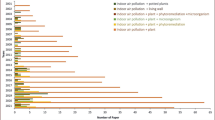Abstract
Understanding the volatilization properties of gasoline components in soils is of fundamental importance in the field of geoenvironments. A series of experiments were performed to investigate the effects of temperature, soil water content, soil organic matter content, as well as mean particle size on volatilization rate of total petroleum hydrocarbons (TPH) and the paraffin (n-paraffin and isoparaffin), olefin, naphthene, and aromatic (PONA) components in four typical Japanese soils. The results of this study can be summarized as follows. (1) Volatilization rate of gasoline in a soil is concentration-dependent; extensive volatilization occurs above a certain threshold, while volatilization becomes very slow below this threshold. (2) Compared to other factors, temperature and soil organic matter content have greater effects on volatilization rate of gasoline in soils. The volatilization rate is proportional to temperature, but inversely related to soil organic matter content. (3) The characteristics of time-dependent decreases of TPH and PONA components in soils are similar. The volatilization rate of olefin is higher than those of other components. In addition, volatilization of olefin is also more sensitive to temperature as well as organic matter content.





Similar content being viewed by others
References
Arthurs P, Stiver WH, Zytner RG (1995) Passive volatilization of gasoline from soil. J Soil Contam 4:123–135
Central Council for Environment, Japan (2006) A Guideline for countermeasures of soil oil pollution. Central Council for Environment, Japan, p 220 (in Japanese)
Davis EL (1997) How heat can enhance in situ soil and aquifer remediation: important chemical properties and guidance on choosing the appropriate technique, EPA/540/S-97/502, p 18
Donaldson SG, Miller GC, Miller WW (1992) Remediation of gasoline-contaminated soil by passive volatilization. J Environ Qual 21:94–102
Edwards DA, Andriot MD, Amoruso MA, Tummey AC, Bevan CJ, Tveit A, Hayes LA, Youngren SH, Nakles DV (1997) Total petroleum hydrocarbon criteria working group series, vol 4: development of fraction specific reference doses (RfDs) and reference concentrations (RfCs) for total petroleum hydrocarbons (TPH). Amherst Scientific Publishers, Amherst
Fine P, Yaron B (1993) Outdoor experiments on enhanced volatilization by venting of kerosene component from soil. J Contam Hydrol 12:355–374
Galin T, McDowell C, Yaron B (1990) The effect of volatilization on the mass flow of a non-aqueous pollutant liquid mixture in an inert porous medium: experiments with kerosene. J Soil Sci 41:631–641
Gidda T, Stiver WH, Zytner RG (1999) Passive volatilization behavior of gasoline in unsaturated soils. J Contam Hydrol 39:137–159
Jarsjö J, Destouni G, Yaron B (1994) Retention and volatilization of kerosene: laboratory experiments on glacial and post-glacial soils. J Contam Hydrol 17:167–185
Johnson RL, Perott M (1990) Gasoline vapor transport through a high-water-content soil. J Contam Hydrol 8:317–334
Nakano M, Miyazaki T, Shiozawa S, Nishimura T (1995) Methodologies for measuring soil environments. The University of Tokyo Press, Tokyo, pp 59–60
Spencer WF, Farmer WJ, Jury WA (1982) Behavior of organic chemicals at soil, air, water interfaces as related to predicting the transport and volatilization of organic pollutants. Environ Toxicol Chem 1:17–26
Acknowledgments
The authors wish to acknowledge the financial support of the Ministry of the Environment, Japan. We are also grateful to Ms. Keiko Ogawa of AIST, Japan, for assistance with experiments and analyses.
Author information
Authors and Affiliations
Corresponding author
Rights and permissions
About this article
Cite this article
Nishiwaki, J., Kawabe, Y., Sakamoto, Y. et al. Volatilization properties of gasoline components in soils. Environ Earth Sci 63, 87–95 (2011). https://doi.org/10.1007/s12665-010-0671-7
Received:
Accepted:
Published:
Issue Date:
DOI: https://doi.org/10.1007/s12665-010-0671-7




